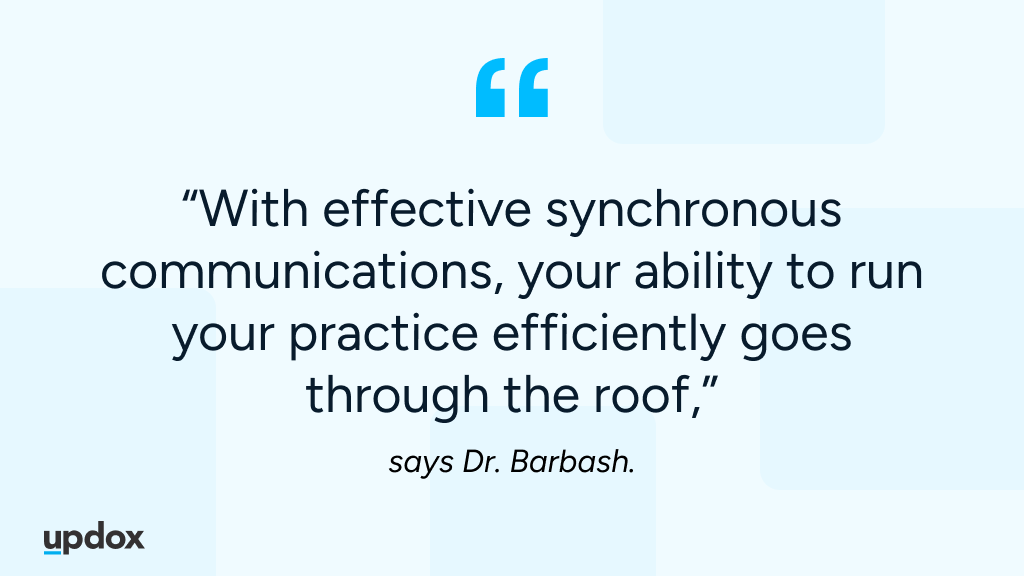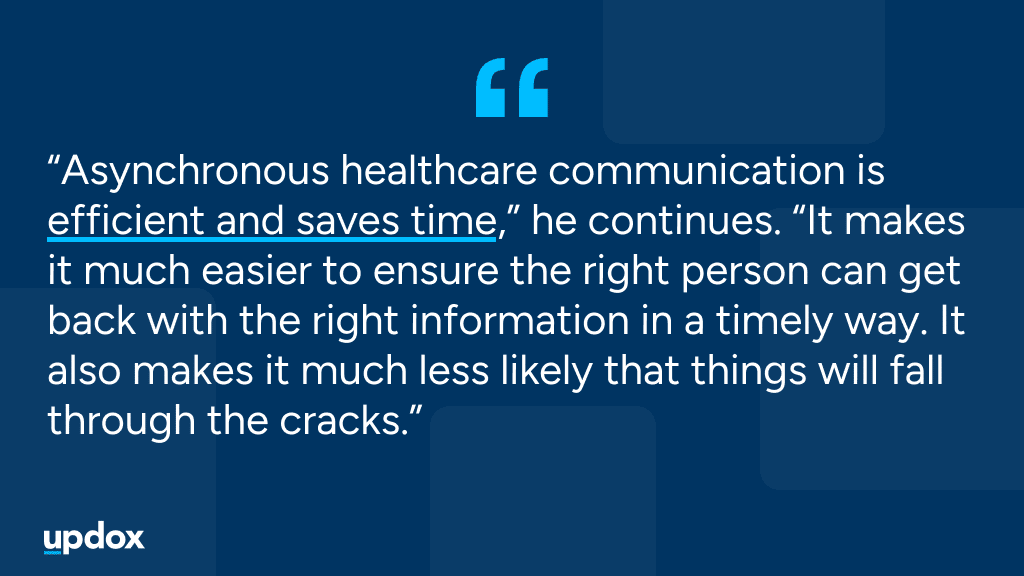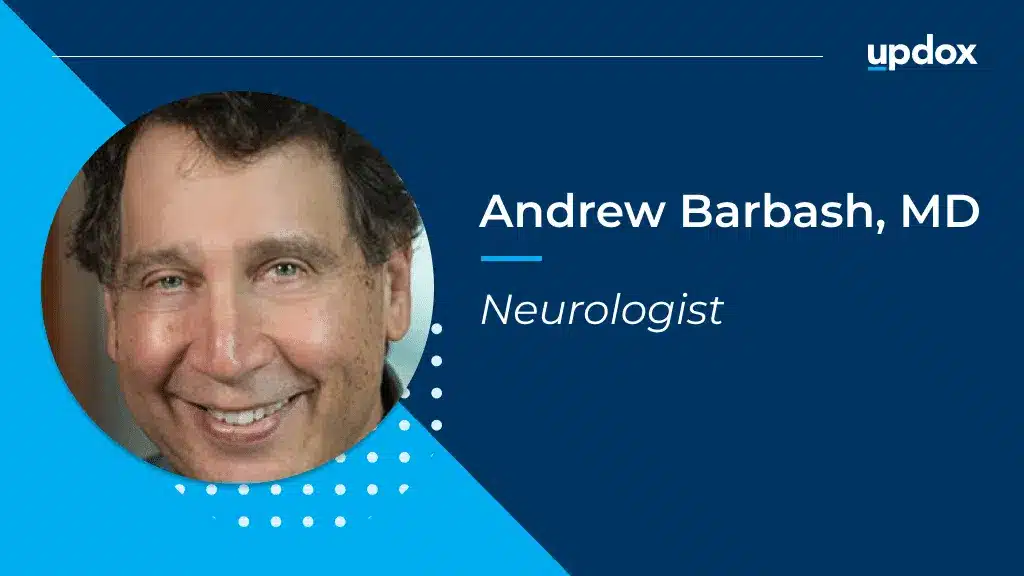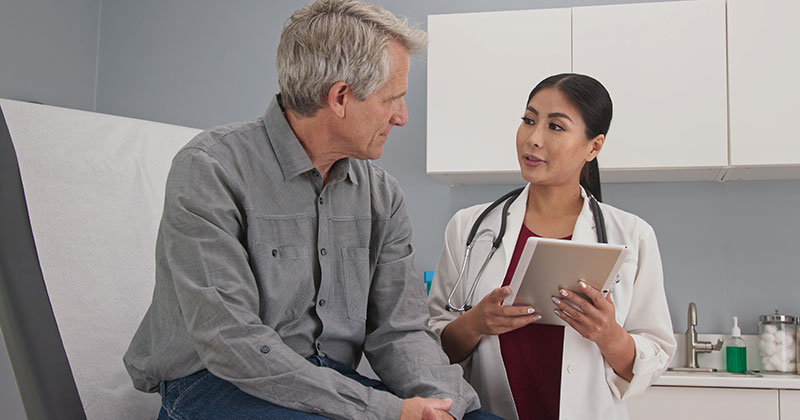High-quality healthcare communication is vital for good patient experiences and professional exchanges. But while we have more modes of contact than ever before, they aren’t always as responsive as they could be.
Updox provides healthcare communication solutions that address this issue. We’ve spoken to Dr. Andrew Barbash, MD, the founder of Updox, to learn more about these innovative tools. Here, he tells us how medical practices aid asynchronous (non-live) communication with patients and other medical professionals.
Why Is Asynchronous Healthcare Communication Important?
Sometimes healthcare providers need to communicate in real time. This could be in a face-to-face visit or a telehealth consultation. Or it could be to convey an urgent message to a colleague or another healthcare provider.
However, there are other times where having a conversation in real time isn’t necessary. That’s where asynchronous communication comes in.
Asynchronous communication refers to communication that does not occur in real-time, such as email or text messages. Asynchronous communication flexes around challenges. This may include busy schedules, staff availability, and lack of time.
It lets staff optimize resources and review information when they get the opportunity. It also helps healthcare staff triage the in-coming workflow. Some routine inquiries simply don’t need an urgent, real-time conversation.
Offering the ability to rank interactions is one of its most useful benefits.
“With effective synchronous communications, your ability to run your practice efficiently goes through the roof,” says Dr. Barbash.

Who Benefits from Asynchronous Healthcare Communication Tools?
The short answer is everyone. “Everybody involved in healthcare from patients to staff,” says Dr. Barbash. “Everyone’s efficiency is enhanced by effective asynchronous communication,” he continues.
These tools remove a lot of the frustration around communicating. Healthcare professionals are busy, so trying to get the answer to a question in real time can be tough.
Asynchronous communication allows clinicians and their patients to ask and answer questions via Direct Secure Messaging, text or fax and check back in their own time. This makes the communication process much more streamlined.
“It’s more helpful to submit a question and get a correct answer from the correct person a day later,” says Dr. Barbash.
This mode is also perfect for doctor-patient messaging. If professionals don’t have the time to take part in a live conversation during the hours they see patients, they can answer questions when they get a break.
Asynchronous Healthcare Communication in Action
There are many examples of how asynchronous communication tools work in healthcare. This could be anyone from a patient with a non-urgent question about their recent visit or someone requesting test results.
If there isn’t a quick and easily accessible place for them to find that information, the patient may get frustrated as a result.
The Updox Patient Portal allows patients to perform multiple tasks in one place. These include accessing results, scheduling appointments, paying bills, and interacting with your practice.
Allowing patients to help themselves improves their satisfaction while also cutting down on time-consuming tasks for your staff.
There are times your staff may need to request or release a patient’s medical records. Calling a healthcare practice may not get you the information you need immediately.
A better solution is to submit your request via Direct Secure Messaging, which allows you to use Updox’s HIPAA-Compliant eFax tool to receive records safely and securely.
“One-way communication is another example of asynchronous communication. It allows people to determine what’s the best method to receive that type of message,” says Dr. Barbash.
“For example, if you want to let everybody who’s over 65 know that we’ve run out of vaccines. You can message to say we’ll have them next week and we’ll send out an update.”
Here, you can send the initial message to many recipients via Updox’s Broadcast Messaging service. Then the Appointment Reminders tool prompts patients to schedule an appointment to come into the office.
Immediate, Responsive, and Appropriate
Dr. Barbash makes another valid point—asynchronous communication can still be immediate. “We’re on our phones 24/7 anyway. So, if I snap a pic and text it right over, that almost makes asynchronous care synchronous in a sense.”
Having data at their fingertips means clinicians can be responsive. If it’s urgent, they can react right away. They may call the patient in or use virtual consultation platforms. Otherwise, they can time their response accordingly.
“In this way, asynchronous messaging also supports the synchronous communication process,” he adds.
Asynchronous communication also helps the patient consider the urgency of their issue.
“When you message rather than call, you soon realize that most issues are not urgent,” says Dr. Barbash.
“You switch your mindset. You understand that a reliable asynchronous communication process offers a timely response. You realize how urgent an issue really is.”
What Makes Updox Asynchronous Communication Tools Unique?
Updox solutions offer unique features that provide a seamless, confidential, and intuitive experience for users.
First, they synchronize with one another. For example, you can use contact information from the patient’s EMR in your communications, so you don’t have to look up an address.
“Communication comes from the same inbox used to process patient files,” explains Dr. Barbash.
Updox solutions also operate securely so only authorized recipients can view certain data. You can set up unique permissions for different purposes and audiences. This means that information is filtered to be seen only by the appropriate people.
Updox tools are also intuitive and cut down on repetitive, time-consuming tasks. Dr. Barbash explains, “You can create simple text from a screenshot or a template. Then you can send it out securely to a mobile phone or email address, depending on the preference.”

The Value That Asynchronous Healthcare Communication Tools Offer
Asynchronous healthcare communication tools add value to providers and patients alike.
“These tools are universally available to patients,” says Dr. Barbash. “They can use them from their phone or any device any time they like.”
“Asynchronous healthcare communication is efficient and saves time,” he continues. “It makes it much easier to ensure the right person can get back with the right information in a timely way. It also makes it much less likely that things will fall through the cracks.”
This mode of communication also helps practices manage their own workflow. It aids financial and operational efficiency while ensuring data security.
Ultimately, it’s about patient engagement. Communicating using the latest technology means high-quality interactions with patients. Their expectations are met, and relationships are enhanced.
What Next?
The benefits of asynchronous healthcare communication tools are plain to see. Updox tools empower your practice to become more efficient while patient satisfaction increases.
Learn how Updox products can make a difference. Schedule your customized demo today!





